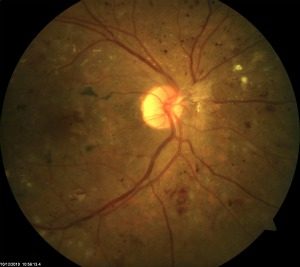What is Diabetic Retinopathy?
 If you are living with diabetes in Austin, diabetic retinopathy may become a vision-threatening condition. Monitoring for this condition is the reason your primary care physician will ask you to have periodic eye exams. High blood sugar resulting from diabetes causes damage to small blood vessels. The small blood vessels of the eye are susceptible to this damage. The damage to blood vessels may cause leakage or decreased blood flow. Early changes are referred to as non-proliferative diabetic retinopathy. This may progress to proliferative diabetic retinopathy if the diabetes is not controlled.
If you are living with diabetes in Austin, diabetic retinopathy may become a vision-threatening condition. Monitoring for this condition is the reason your primary care physician will ask you to have periodic eye exams. High blood sugar resulting from diabetes causes damage to small blood vessels. The small blood vessels of the eye are susceptible to this damage. The damage to blood vessels may cause leakage or decreased blood flow. Early changes are referred to as non-proliferative diabetic retinopathy. This may progress to proliferative diabetic retinopathy if the diabetes is not controlled.
Diabetic Macular Edema
The macula is an anatomic term that refers to the central area of the retina. The macula is responsible for the sharp and direct vision needed for activities such as reading, driving or recognizing fine details. Diabetic macular edema is the collection of fluid in the central retina that results from vessels damaged by diabetes. This fluid can collect and cause swelling which distorts the anatomy and therefore the vision in the macula. The treatment of macular edema may involve laser treatment or injection of medication into the eye. The treatment effect is to decrease leakage and allow the eye to “dry” the central retina and to prevent progression of the damage.
Macular Ischemia
Damaged blood vessels may not be capable of supplying enough oxygen to the tissues of the macula. This can lead to cell death and decreased vision. There is no treatment for tissue damaged by ischemia.
Can Diabetic Retinopathy Be Corrected?
The most important treatment is to maintain strong diabetic control. Treatment of diabetic retinopathy varies based on its severity and the location of the disease. Retinopathy found in the peripheral retina may just require careful monitoring. For patients with retinopathy that impacts central vision, laser treatment or medication injections inside the eye are often necessary to halt its progression. Combined with a laser procedure, these can seal leaking blood vessels. To prevent diabetic retinopathy from causing permanent vision loss, early diagnosis and treatment are crucial. As long as the disease is detected early and managed diligently, it can be delayed or arrested in its more vision-damaging stages. Careful monitoring with the help of your ophthalmologist is key.
Proliferative Diabetic Retinopathy
If diabetes is not well controlled it is possible for the damage in the eye to progress to proliferative diabetic retinopathy. Proliferation refers to the creation within the eye of new blood vessels. These new blood vessels are a response to a hormone secreted by the cells of the retina that are not receiving enough oxygen. The new blood vessels are pathologic and fragile. They can break and cause bleeding within the back of the eye. They may also contract and cause pulling on the retina tissues. This can lead to retinal distortion or to breaks in the retina or retinal detachment. Treatments are aimed at causing regression of these abnormal blood vessels. Treatments include laser treatment to the back of the eye and injections of medicine to block the hormone that causes growth of the new vessels.
Schedule an appointment with our Austin Retina Specialist today!
